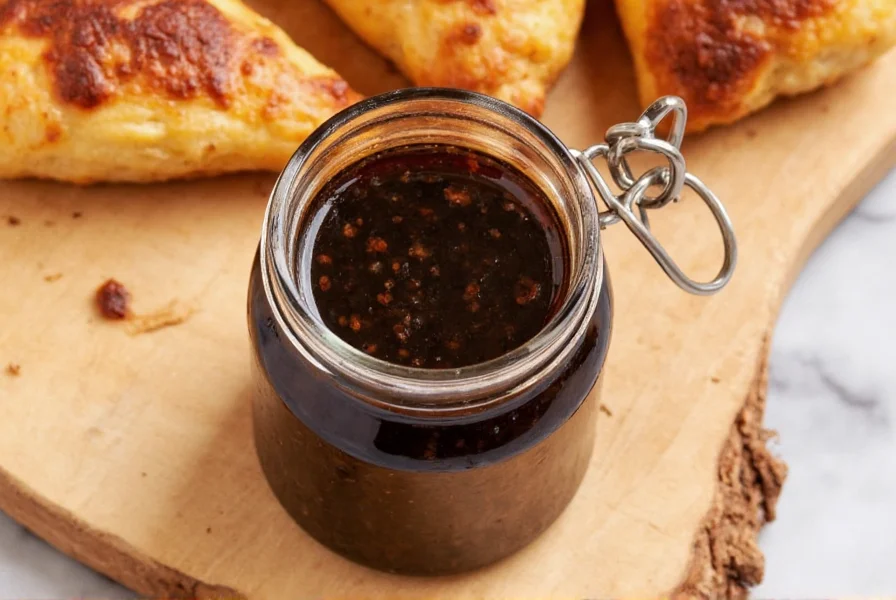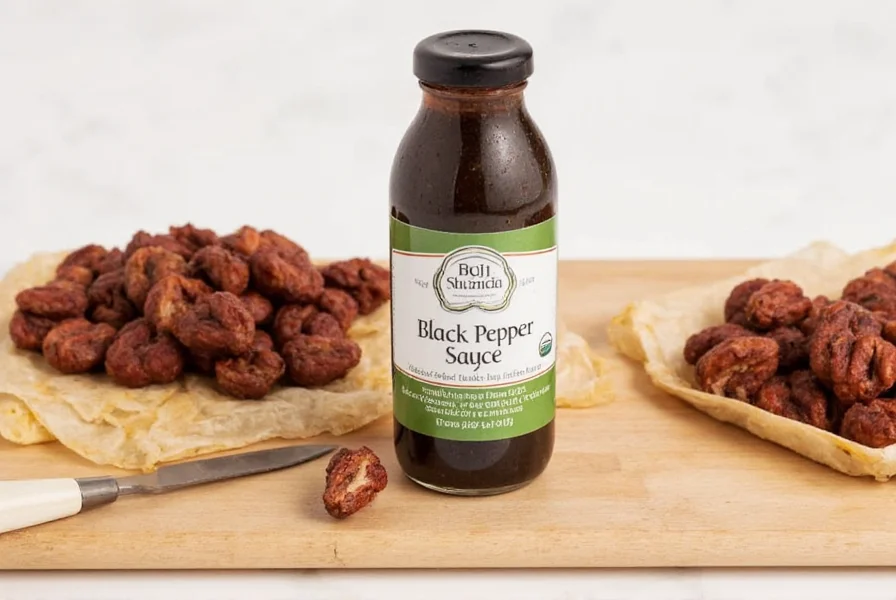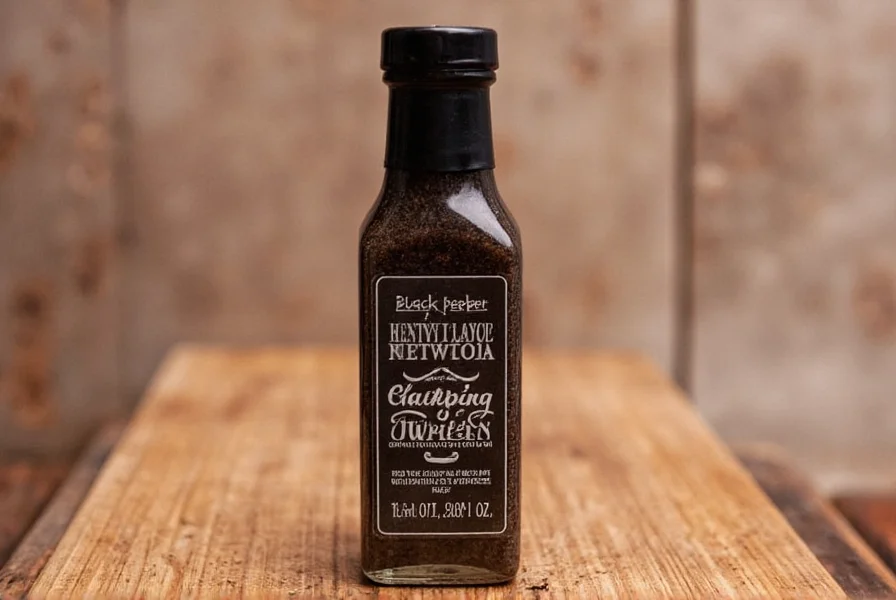Understanding what black pepper sauce is and how to use it properly transforms ordinary meals into restaurant-quality experiences. This guide explores the sauce's origins, variations, and practical applications while providing a reliable homemade recipe that outperforms store-bought alternatives.
The Origins and Evolution of Black Pepper Sauce
Black pepper sauce traces its roots to European culinary traditions, where coarsely ground peppercorns were simmered in cream or wine to accompany roasted meats. The French poivre noir preparation became particularly influential, using cognac and demi-glace to create a luxurious accompaniment for steak frites. Asian adaptations emerged later, incorporating soy sauce, oyster sauce, and fresh ginger to complement stir-fried dishes.
Today's global variations reflect regional preferences. Western versions often feature cream or butter bases with generous cracked peppercorns, while Chinese black pepper sauce relies on soy-based liquids and aromatic vegetables. The key distinction lies in the pepper preparation—authentic recipes use freshly cracked or coarsely ground peppercorns rather than pre-ground powder, preserving essential oils that deliver superior flavor.

Essential Ingredients and Regional Variations
The foundation of any quality black pepper sauce consists of four critical components:
| Component | Western Style | Asian Style |
|---|---|---|
| Peppercorn Base | Coarsely cracked Tellicherry peppercorns | Freshly cracked black peppercorns with white pepper blend |
| Liquid Foundation | Beef demi-glace or pan drippings | Chicken broth with soy sauce |
| Aromatic Elements | Shallots, garlic, thyme | Ginger, garlic, green onions |
| Thickening Agent | Butter or cream reduction | Cornstarch slurry |
Professional chefs emphasize using Tellicherry peppercorns for their complex flavor profile—they contain higher concentrations of piperine, the compound responsible for pepper's characteristic heat. When making homemade black pepper sauce, always add cracked peppercorns early in the cooking process to allow flavors to meld, but avoid prolonged boiling which can make the sauce bitter.
Perfect Pairings: What Dishes Go Well With Black Pepper Sauce
Black pepper sauce complements proteins with robust flavors that can stand up to its intensity. The best black pepper sauce for steak features a rich demi-glace base that caramelizes beautifully with seared beef. For poultry, use a lighter version with chicken stock and reduced pepper quantity to avoid overwhelming delicate flavors.
Asian-style black pepper sauce shines in stir-fries with beef, mushrooms, and bell peppers. The sauce's heat cuts through the richness of meats while enhancing vegetable sweetness. When preparing black pepper sauce for stir fry, add it during the final minute of cooking to preserve the peppercorns' volatile oils.
Avoid pairing black pepper sauce with:
- Delicate fish like sole or flounder
- Mild cheeses such as mozzarella
- Sweet dishes or desserts
- Raw vegetable salads
How to Make Black Pepper Sauce From Scratch
This professional-grade recipe yields a balanced sauce with layered heat and complexity. The how to make black pepper sauce from scratch method below produces enough for four servings:
Ingredients
- 2 tablespoons coarsely cracked black peppercorns
- 1 cup quality beef stock (or chicken stock for poultry dishes)
- 3 tablespoons unsalted butter
- 1 small shallot, finely minced
- 2 garlic cloves, crushed
- 2 tablespoons brandy or dry sherry
- 1 teaspoon soy sauce (for umami depth)
- Salt to taste
Step-by-Step Preparation
- Toast cracked peppercorns in a dry skillet over medium heat for 2 minutes until fragrant
- Melt butter in saucepan and sauté shallots until translucent (2-3 minutes)
- Add garlic and toasted peppercorns, cook for 1 minute
- Deglaze with brandy, scraping up any browned bits
- Pour in stock and soy sauce, bring to gentle simmer
- Cook uncovered for 12-15 minutes until reduced by half
- Season with salt (sparingly, as soy sauce adds saltiness)
- Strain through fine mesh sieve for smooth texture (optional)
The secret to exceptional black pepper sauce lies in the pepper-to-liquid ratio. Start with 2 tablespoons cracked peppercorns per cup of liquid, then adjust to taste. For restaurant-quality results, bloom the cracked peppercorns in warm oil before adding liquids—this technique extracts maximum flavor from the essential oils.

Common Mistakes to Avoid
Many home cooks encounter issues with black pepper sauce due to these preventable errors:
- Using pre-ground pepper - Loses 70% of volatile flavor compounds within hours of grinding
- Adding pepper too late - Insufficient time for flavors to meld with other ingredients
- Over-reducing the sauce - Concentrates bitterness from overcooked peppercorns
- Skipping the toast step - Raw pepper flavor lacks complexity and depth
- Using low-quality stock - Forms the flavor foundation; poor stock yields poor sauce
Black pepper sauce vs peppercorn sauce represents another common confusion. True peppercorn sauce typically uses a mix of colored peppercorns (black, white, green, pink) for varied flavor notes, while traditional black pepper sauce relies solely on black peppercorns for consistent heat profile.
Storage and Shelf Life Guidelines
Properly stored, homemade black pepper sauce maintains quality for:
- Refrigerator: 5-7 days in airtight container
- Freezer: 2-3 months in ice cube trays for portioned use
When reheating, add a splash of stock or water to restore consistency. Never microwave black pepper sauce on high power—gentle warming preserves the delicate balance of volatile compounds. For storage tips for black pepper sauce, always cool completely before refrigerating to prevent condensation that dilutes flavor.
Frequently Asked Questions
What's the difference between black pepper sauce and peppercorn sauce?
Black pepper sauce uses only black peppercorns for a consistent heat profile, while peppercorn sauce typically combines multiple peppercorn varieties (black, white, green, pink) for complex flavor notes. Authentic black pepper sauce focuses on depth from a single pepper type, whereas peppercorn sauce emphasizes variety.
Can I make black pepper sauce without alcohol?
Yes, substitute the brandy or sherry with additional beef or chicken stock plus 1 teaspoon of balsamic vinegar. The vinegar provides the necessary acidity to balance flavors that alcohol normally contributes through deglazing.
Why does my black pepper sauce taste bitter?
Bitterness usually comes from overcooked peppercorns or excessive reduction. Black pepper compounds break down after prolonged boiling, releasing bitter elements. To fix this, reduce cooking time for peppercorns and avoid boiling the sauce vigorously after adding them.
Which steak cut works best with black pepper sauce?
Ribeye and strip steaks provide the ideal fat content to balance black pepper sauce's heat. The marbling melts into the sauce, creating a luxurious texture. Avoid lean cuts like filet mignon which lack sufficient fat to complement the sauce's intensity.
How can I adjust the heat level in black pepper sauce?
Control heat by adjusting both quantity and preparation of peppercorns. For milder sauce, use 1.5 tablespoons instead of 2, and add them later in cooking. For more heat, increase to 2.5 tablespoons and toast them longer. Freshly cracked pepper always delivers more controlled heat than pre-ground versions.











 浙公网安备
33010002000092号
浙公网安备
33010002000092号 浙B2-20120091-4
浙B2-20120091-4